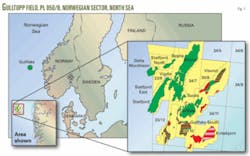StatoilHydro completes, flows 10-km horizontal Gulltopp well
StatoilHydro drilled and completed a long horizontal well off the Gullfaks-A platform, increasing the possibility of platform drilling to remote prospects. The Gulltopp well began flowing oil from 9,910 m TD on Apr. 8.
In early 2004, Statoil ASA announced that it would deepen an existing producing well from the Gullfaks A platform to reach the Gulltopp accumulation 10 km away (OGJ, Feb. 9, 2004, p. 8).
Last month, StatoilHydro characterized it as the longest producing well in the world drilled from an offshore platform.
Gulltopp has recoverable reserves of 4 million std. cu m of oil and 500 million std. cu m of gas and the company expects a production plateau of 16,000 bo/d.1
The reservoir pressure was 316 bar when the field was discovered (50 bar depleted), and the permeabilities are medium (50 md) to high (5 Darcy).2
‘Dolly’
Previously named the Dolly prospect, Gulltopp field is in the Tampen area of the northern Norwegian North Sea, 5 km north of Gullfaks satellite fields Gullveig and Rimfaks (Fig. 1). The field is operated by majority owner StatoilHydro (70%), on behalf of license partner Petoro AS (30%).
In 2002, the Deepsea Trym semisubmerible rig, owned by Odfjell Drilling AS, drilled the 34/10-47ST2 wildcat on Dolly (OGJ, Dec. 9, 2002, p. 8).
In January 2007, Odfjell sold the Deepsea Trym, a second-generation semisub, of modified Aker H-3 design, to Songa Trym AS (Songa Offshore), and it was renamed the Songa Trym. The rig continues to drill for StatoilHydro in the North Sea.
Operations
Before Gulltopp, Statoil’s longest production well was the 34/10-A-47T2, which reached 9,052 m MD and was sidetracked to 8,835 m MD. It was drilled in 2001 to Gullfaks South from the Gullfaks A platform.2
A year later, Statoil drilled the Dolly discovery well on Gulltopp.
In 2004, Statoil considered both a subsea solution and long reach drilling to exploit the Gulltopp field.2
Statoil began directional drilling toward Gulltopp in April 2005 and ultimately drilled nearly 900 m farther than its 2001 record. In order to produce the field, the company faced either drilling and producing through a subsea template or attempting to drill production wells from the nearest platform. Statoil initially estimated the cost of drilling the extended reach well at $43.9 million, about 25% of the cost it estimated necessary to develop Gulltopp with a subsea template and dedicated multiphase flowlines (OGJ, Feb. 9, 2004, p. 8).
Last month, after completing the 3-year project, StatoilHydro said the well was “considerably more expensive than initially assumed.”
The rig on the Gullfaks A platform is in 439-ft water and StatoilHydro describes the Gulltopp oil as “exceptionally shallow.” The reservoir is 2,430 m below the sea surface.1
The company planned to deviate the Gullfaks A sidetrack to 83° from vertical to reach the Brent reservoir and then deviate to 90° through the formation (OGJ, Feb. 9, 2004, p. 8).
ERD
Drilling contractor Seawell Ltd. has managed platform rigs in the North Sea since 1977, with about 35% of the market off Norway and experience in extended-reach drilling. In 1995, Seawell drilled an extended-reach, world record well from Oseberg C to a total depth 9,327 m for Hydro.
In August 2004, Statoil awarded Seawell the Tampen production drilling operations contract for Statfjord and Gullfaks fields.
StatoilHydro renewed the contract in March 2008; the 2-year extension begins Oct. 1 (OGJ Online, Mar. 13, 2008). Gullfaks A and B have 42 wells each, and C has 52, totaling 136. Seawell has performed managed pressure and through-tubing drilling at Gullfaks.
It is involved in planning and upgrading of the equipment for extended-reach drilling. Seawell says that StatoilHydro is considering wells with 12,000-15,000 m reach on Gullfaks A and C for the future.3
Key to success
To reach Gulltopp, StatoilHydro had to drill about 4 m horizontally for each 1 m vertically; most of the well path had an inclination of 7º (Fig. 2).
The shallow angle meant there was a great deal of friction while drilling and running casing. StatoilHydro chose to fill the 8-km casing with air, instead of drilling mud, in order to reduce drag and “float” the casing in the nearly horizontal well. “This was the key to success,” the company said.1
The extreme drilling required StatoilHydro to upgrade the brake system on the drilling rig and the power supply for the platform.
Arne Sigve Nylund, head of operations west at StatoilHydro, described it as “the company’s most demanding drilling operation.”
Among the new technologies Statoil used to drill the well were newly designed 7-in. polymer control line protectors, beginning in October 2005 (OGJ, Aug. 15, 2005, p. 44).
Geir Slora, head of drilling and wells at StatoilHydro, said that the suppliers involved made a “crucial contribution” to the success of the Gulltopp well.
Production
The main Gullfaks field lies in Block 34/10 in the northern part of the Norwegian North Sea and has been developed with three large concrete production platforms (A, B, C).
Gullfaks A is used for storing and exporting stabilized crude from Vigdis and Visund fields.
Production at Gullfaks is commingled from the Gullfaks A/B/C, Gullfaks satellites, Vigdis, Visund, and Tordis fields. Gullfaks blend is a light, low sulfur North Sea crude oil, 37.5º API.4
Oil is loaded into shuttle tankers, and associated gas is piped to the Kårstø gas treatment plant north of Stavanger and then on to continental Europe.
References
- “Gulltopp sets world record,” Apr. 14, 2008, www.statoilhydro.com.
- Anes, Hallstein M., Stoltenberg, Lasse, and Sande, Per L., “The Gulltopp Field Development: Subsea Solution vs. Long Reach Platform Well,” SPE offshore Bergen Drilling, Completion, and Reservoir Management Seminar, Bergen, Apr. 20, 2004, www.spe.no/bergen/doc/one_day_seminar_04.
- Production drilling, www.seadrill.com.
- “Gullfaks blend,” www.statoilhydro.com.


